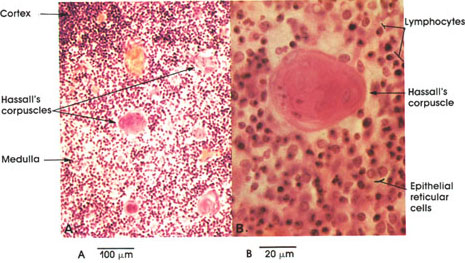

Ronald A. Bergman, Ph.D., Adel K. Afifi, M.D., Paul M. Heidger,
Jr., Ph.D.
Peer Review Status: Externally Peer Reviewed

Human, 10% formalin, H. & E., A. 162 x., B. 612 x.
In A, note the cortex of the thymic lobule, composed of densely packed lymphatic tissue, and the medulla, composed of looser lymphatic tissue containing Hassall's corpuscles. The latter are diagnostic for the thymus. They vary in size and are formed of concentrically arranged polygonal or flattened cells with a hyalinized degenerated core.
In B, a Hassall's* corpuscle is seen at higher magnification. Note also the abundance of lymphocytes and the epithelial reticular cells. The latter are characterized by a large pale nucleus and are derived from embryonic entoderm rather than from mesenchyme.
*Hassall was a nineteenth-century English physician.
Next Page | Previous Page | Section Top | Title Page
Please send us comments by filling out our Comment Form.
All contents copyright © 1995-2025 the Author(s) and Michael P. D'Alessandro, M.D. All rights reserved.
"Anatomy Atlases", the Anatomy Atlases logo, and "A digital library of anatomy information" are all Trademarks of Michael P. D'Alessandro, M.D.
Anatomy Atlases is funded in whole by Michael P. D'Alessandro, M.D. Advertising is not accepted.
Your personal information remains confidential and is not sold, leased, or given to any third party be they reliable or not.
The information contained in Anatomy Atlases is not a substitute for the medical care and advice of your physician. There may be variations in treatment that your physician may recommend based on individual facts and circumstances.
URL: http://www.anatomyatlases.org/